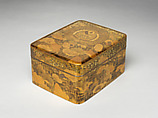Sutra Box with The Peacock Wisdom King
Attributed to Shirayama Shōsai 白山松哉 Japanese
Not on view
The lid of this deep lacquer box is embellished with the Peacock Wisdom King (Japanese: Kujaku Myōō, Sanskrit: Mahamayuri Vidyaraja), a rare iconography in Japanese lacquer art. The Great Peacock King is a bodhisattva of Indian origin and the only female Wisdom King in Mahayana Buddhism. The Peacock Wisdom King is believed to have the power to protect devotees from poisoning, either physical or spiritual, including desire, ill will, and ignorance as in India the peacock is known to eat poisonous snakes and turn the poison into beauty. In Japan, the deity was also responsible for averting disasters, illness in the imperial family, and for safe childbirth of the empress. On this box she is represented as a beautiful, feminine figure with exquisite jewelry and richly embellished garments on a lotus throne riding on the back of a peacock, which has spread out its tail feathers behind the deity to create a unique mandorla. The Wisdom King and her avian vehicle are depicted in great detail, taking advantage of several lacquer techniques, mainly the polished back togidashimaki-e, line and needle drawing, very fine and sophisticated inlays of meticulously cut gold and silver foil. Very few modern lacquer artists have possessed this level of mastery over both materials and techniques. This fact, along with the style of the work and the careful selection of the gold powders used, leave little doubt that the box is the work of Shirayama Shōsai (1853–1923), an Imperial Household Artist, who was well-know of his excellent togidashimaki-e works and for his careful attention to the precious metal powders used.
This image cannot be enlarged, viewed at full screen, or downloaded.
This artwork is meant to be viewed from right to left. Scroll left to view more.



